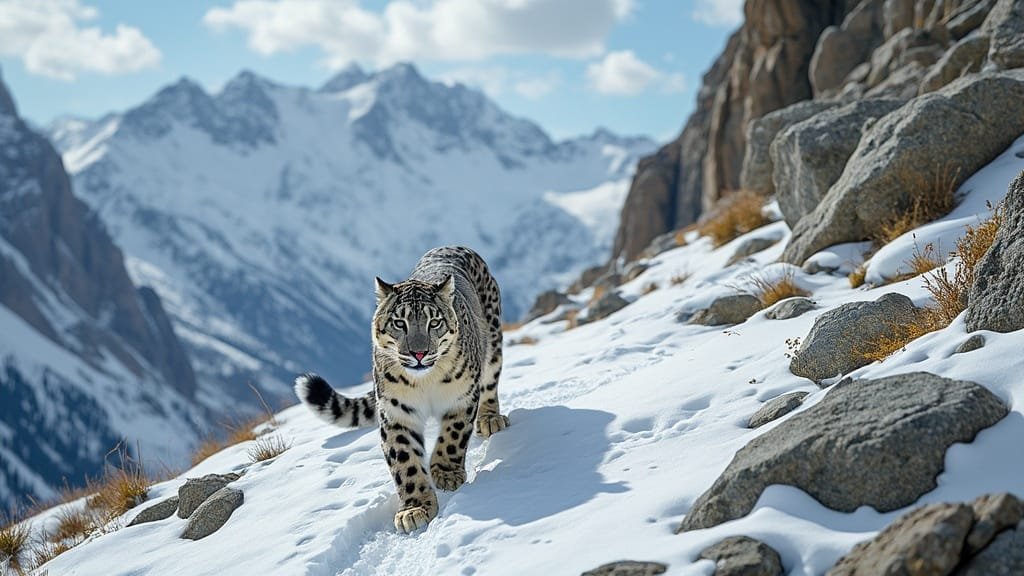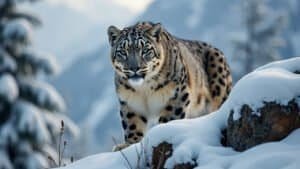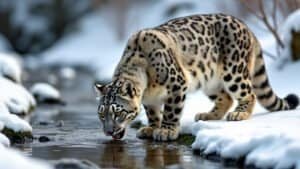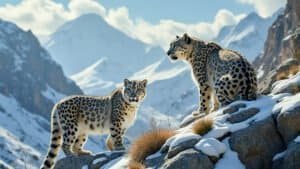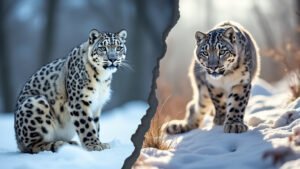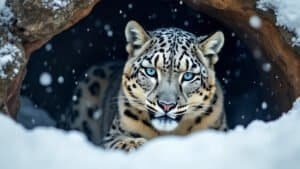Introduction
Snow leopards are elusive big cats that inhabit high-altitude regions of Central and South Asia. Their migration is essential for survival, enabling them to find food and adapt to seasonal changes
This article explores the factors driving snow leopard migration, including prey availability, environmental influences, and human impact
We will delve into how they navigate rugged terrain, adapt to climate change, and why conservation efforts are critical for maintaining their movement patterns
Understanding Snow Leopard Migration
Snow leopards are highly adapted to the mountainous landscapes of Central and South Asia, spanning 12 countries including Nepal, China, and Mongolia
These regions feature steep slopes, rocky outcrops, and snow-covered peaks, which are integral to the snow leopard’s survival. Migration within their geographical range is driven by the need to find prey, avoid environmental hardships, and maintain their territorial dominance
Unlike long-distance migratory species, snow leopards exhibit more localized movement patterns, dictated largely by ecological factors
Why Snow Leopards Migrate Within Their Range
Snow leopards are obligate carnivores, relying primarily on prey such as blue sheep, ibex, and marmots. The availability of these animals fluctuates with the seasons, prompting snow leopards to move within their territories
In winter, prey often descends to lower altitudes in search of vegetation, and snow leopards follow suit to capitalize on this migration. Conversely, during the summer, prey species ascend to higher elevations, and snow leopards adjust their movements accordingly
Territorial needs also drive snow leopard migration. Each individual requires a vast home range—males often cover territories up to 200 square miles
Migration enables them to patrol their domain, secure mating opportunities, and avoid direct competition with other predators. Female snow leopards, while slightly less mobile, are similarly influenced by the need to find safe denning areas for their cubs
Overview of Snow Leopard Habitat and Range
The snow leopard’s habitat spans altitudes ranging from 9,800 to 17,000 feet, where temperatures can drop below -40°F. These extreme conditions create unique challenges, including scarce resources and harsh weather, which dictate the necessity for movement
Snow leopards are built for this environment, with dense fur, powerful limbs, and long tails for balance. Migration helps them maximize resource availability within these tough landscapes
However, migration doesn’t mean aimless wandering. Snow leopards tend to follow established routes within their home ranges
Studies like Sharma et al. (2014) reveal that their movements are influenced by specific environmental markers, such as ridgelines and river valleys, which act as natural corridors. These routes are crucial for maintaining genetic diversity by facilitating encounters between otherwise isolated populations
Key Factors Driving Migration
Several factors determine the extent and frequency of snow leopard migration:
Prey Availability: Seasonal movements of prey are a major determinant of snow leopard migration, as the predator must follow its food sources
Climate Conditions: Severe winters or unexpected weather changes may push snow leopards into areas with milder conditions
Human Activity: Habitat fragmentation due to development can force snow leopards to seek new territories, disrupting their natural migratory patterns
Intraspecies Competition: Migration helps snow leopards avoid conflicts with others of their kind, ensuring territorial stability
Recent studies, such as McCarthy et al. (2005), emphasize that snow leopards rely on consistent habitat connectivity for migration. Protected corridors and reduced human interference are critical to their survival
Seasonal Movement and Prey Availability
Snow leopards are apex predators in their ecosystem, and their movements are intrinsically linked to the seasonal patterns of prey species. This connection ensures their survival in an environment where resources are often limited
By understanding how snow leopards respond to prey availability, we gain insight into their adaptive strategies and the challenges they face in sustaining their populations
How Seasonal Prey Availability Impacts Migration
The primary prey for snow leopards includes ungulates like blue sheep (bharal), ibex, and argali, as well as smaller animals such as hares and marmots
During winter, the harsh conditions at high altitudes drive these herbivores to descend into lower valleys, where vegetation is more accessible. Snow leopards follow this downward migration, tracking their prey across rugged terrain and steep slopes
This seasonal pattern reverses in the summer. As vegetation regrows at higher elevations, prey animals return to the alpine meadows, prompting snow leopards to ascend as well
This cyclical movement allows snow leopards to sustain their caloric needs year-round despite the challenging environment. However, prey availability can vary significantly depending on regional conditions, creating disparities in snow leopard movement across their range
Studies like Li et al. (2017) show that snow leopards adjust their hunting strategies based on prey density. When prey is abundant, they minimize travel and conserve energy by focusing on local hunting grounds
Conversely, in prey-scarce areas, they may traverse longer distances, increasing the risk of encountering competitors or human settlements
Adapting to Environmental Challenges
Snow leopards face numerous environmental challenges that influence their migration patterns. The steep terrain and thin air of high-altitude habitats demand exceptional physical endurance
Snow leopards are built for this: their powerful limbs allow them to leap up to 30 feet in a single bound, and their thick fur insulates them from freezing temperatures. These adaptations enable them to follow prey into even the most inhospitable regions
Despite these advantages, environmental disruptions such as extreme weather events and climate change pose significant risks. Unseasonal snowfall or prolonged droughts can reduce prey availability, forcing snow leopards to expand their search range. In such cases, they may venture closer to human settlements, increasing the likelihood of conflict
Fragmentation of their habitat further complicates their ability to adapt. Traditional migration corridors may be disrupted by infrastructure projects, such as roads and hydroelectric dams
When these pathways are blocked, snow leopards must navigate around human developments, often at great energetic cost. Sharma et al. (2014) emphasize the importance of maintaining habitat connectivity to mitigate these challenges
Conservation Implications of Prey-Driven Movement
Conserving snow leopards requires a comprehensive understanding of the link between prey availability and movement. Conservation programs must address the dual needs of protecting prey populations and ensuring that snow leopards have access to migratory corridors
Initiatives like those led by the Snow Leopard Trust focus on safeguarding prey species through anti-poaching measures and community engagement
Additionally, understanding prey dynamics can help predict how snow leopards will respond to future environmental changes. By monitoring prey populations and seasonal movements, researchers can develop strategies to mitigate the impacts of habitat loss and climate change on snow leopard migration
Environmental and Climatic Influences on Migration
The extreme environments inhabited by snow leopards are not static. Climate and ecological shifts play a pivotal role in shaping the movement and survival strategies of these big cats
As high-altitude regions undergo rapid changes due to global warming, understanding these influences becomes critical for the conservation of snow leopard populations
Impact of Climate Change on Snow Leopard Migration
Climate change significantly affects the snow leopard’s habitat and migration patterns. Rising temperatures are causing a retreat of the alpine zones where snow leopards and their prey thrive
Warmer climates also alter vegetation patterns, which in turn impact the distribution of herbivores such as blue sheep and ibex. This cascading effect forces snow leopards to adjust their migratory routes to track shifting prey populations
Additionally, climate change is increasing the frequency of extreme weather events, such as unseasonal snowfall or prolonged droughts. Such events can devastate prey populations and reduce the availability of food for snow leopards, compelling them to expand their range
These extended migrations heighten the risk of human-wildlife conflict, particularly in regions where habitat fragmentation limits safe corridors
A study by Forrest et al. (2012) highlights how shrinking snow cover and rising tree lines are gradually pushing snow leopard habitats higher up the mountains, compressing their range and intensifying competition among individuals
Over time, these pressures could result in the isolation of populations, reducing genetic diversity and increasing vulnerability to extinction
Effects of Ecosystem Changes
High-altitude ecosystems are undergoing transformations that directly influence snow leopard migration. For example, the encroachment of livestock grazing into traditional snow leopard habitats is reducing the availability of natural prey
In response, snow leopards are forced to migrate into areas closer to human settlements, often preying on livestock, which can lead to retaliatory killings by local communities
Another ecological factor is the expansion of infrastructure projects in mountainous regions, including roads, mining sites, and hydroelectric dams. These developments fragment the snow leopard’s habitat, disrupting traditional migratory pathways
According to McCarthy et al. (2005), habitat fragmentation is one of the leading threats to snow leopard populations, as it limits their ability to move freely between areas with sufficient prey
Moreover, ecosystem changes such as vegetation shifts and water resource depletion are impacting the herbivore populations that snow leopards depend on
The combined effects of these changes compel snow leopards to explore new areas, increasing their exposure to novel threats such as poaching and competition with other predators
Mitigating Climatic and Environmental Impacts
Efforts to mitigate the effects of climate change and habitat loss are essential for preserving snow leopard migration patterns. Conservation initiatives must prioritize the protection of key habitats and corridors that facilitate movement
Protected areas such as national parks and wildlife reserves are critical, but they need to be complemented by community-driven efforts in surrounding regions to reduce conflicts and promote coexistence
International collaborations like the Global Snow Leopard and Ecosystem Protection Program (GSLEP) are actively addressing these challenges
By integrating climate-resilient conservation strategies, such as monitoring ecosystem changes and promoting sustainable land-use practices, these programs aim to ensure that snow leopards can adapt to their rapidly changing environment
Furthermore, advances in technology, such as satellite tracking and remote sensing, allow researchers to better understand snow leopard movements in response to environmental changes
Such data is invaluable for planning conservation strategies that anticipate future climate impacts and safeguard the long-term viability of snow leopard populations
Human Impact on Snow Leopard Migration
Human activity has become one of the most significant factors influencing snow leopard migration. From habitat fragmentation to conflicts with local communities, the challenges posed by human expansion into mountainous regions are reshaping the migratory behavior of these elusive predators
Understanding and addressing these impacts is crucial for ensuring the survival of snow leopards in their natural environment
Barriers Created by Human Development
Infrastructure development is a major threat to snow leopard migration. Projects such as roads, railways, mining operations, and hydroelectric dams often cut through critical habitats, creating physical barriers that disrupt traditional migratory pathways
These obstructions force snow leopards to detour around developed areas, increasing the energetic costs of migration and limiting access to prey-rich regions
For instance, a study by Chetri et al. (2017) highlights how roads and urban expansion in the Himalayas are leading to habitat fragmentation, which restricts snow leopards’ ability to move freely
Such disruptions not only hinder migration but also isolate populations, reducing genetic exchange and increasing the risk of inbreeding
Livestock grazing, another widespread human activity, further complicates migration. As herders expand grazing territories into high-altitude regions, the competition for resources between livestock and natural prey intensifies
This encroachment often drives prey species away, leaving snow leopards with fewer hunting opportunities and prompting them to travel longer distances in search of food
Conservation Efforts Supporting Migration
Despite these challenges, numerous conservation programs are working to mitigate human impacts on snow leopard migration
One key approach involves creating wildlife corridors that connect fragmented habitats, enabling snow leopards to move more freely across their range. These corridors are carefully planned to avoid areas of high human activity and ensure access to critical resources
Community-based conservation initiatives are also essential for reducing conflict between humans and snow leopards. Programs like those led by the Snow Leopard Trust engage local communities in conservation efforts by providing economic incentives for protecting snow leopards and their habitats
For example, livestock insurance schemes compensate herders for losses due to snow leopard predation, reducing the likelihood of retaliatory killings
Education campaigns and ecotourism projects further promote coexistence by raising awareness of the ecological importance of snow leopards and generating income for local communities. These efforts help foster a sense of stewardship among people living near snow leopard habitats
The Role of Policy and International Collaboration
Effective conservation also requires strong policy frameworks and international collaboration. Initiatives like the Global Snow Leopard and Ecosystem Protection Program (GSLEP) bring together governments, NGOs, and researchers to address cross-border challenges such as habitat fragmentation and climate change
Through coordinated efforts, these programs aim to establish transboundary conservation areas that support snow leopard migration across national borders
In addition, stricter enforcement of anti-poaching laws and regulations against illegal wildlife trade is vital for protecting snow leopards. Human activities, such as poaching and retaliatory killings, not only threaten individual animals but also disrupt migratory patterns by reducing population densities
By strengthening legal protections and involving local communities in surveillance efforts, conservationists can reduce these risks
Future Directions
Looking ahead, technological advancements like GPS tracking and camera traps are improving our ability to monitor snow leopard movements and understand how they are affected by human activities. This data is crucial for designing targeted interventions that address the specific challenges faced by different populations
Moreover, integrating conservation with sustainable development practices can help balance the needs of local communities with the requirements of snow leopard conservation
For example, promoting renewable energy projects that minimize habitat disruption can reduce the environmental footprint of development in mountainous regions. By addressing the root causes of human impact on snow leopard migration, conservation efforts can create a future where these magnificent cats continue to thrive in their natural habitats
Conclusion
Snow leopard migration is a complex and essential aspect of their survival, influenced by prey availability, environmental changes, and human activity
These elusive cats adapt to the harsh conditions of their mountainous habitats by moving within their extensive ranges to find food and navigate seasonal challenges. However, climate change, habitat fragmentation, and human-wildlife conflict are creating unprecedented obstacles that threaten their ability to migrate effectively
Efforts to mitigate these threats are underway through international collaboration, community engagement, and innovative conservation strategies
Protecting migratory corridors, promoting coexistence with local communities, and addressing climate impacts are key to ensuring the long-term survival of snow leopards
By understanding and supporting their migration patterns, we contribute not only to the conservation of this iconic species but also to the preservation of the fragile ecosystems they inhabit
